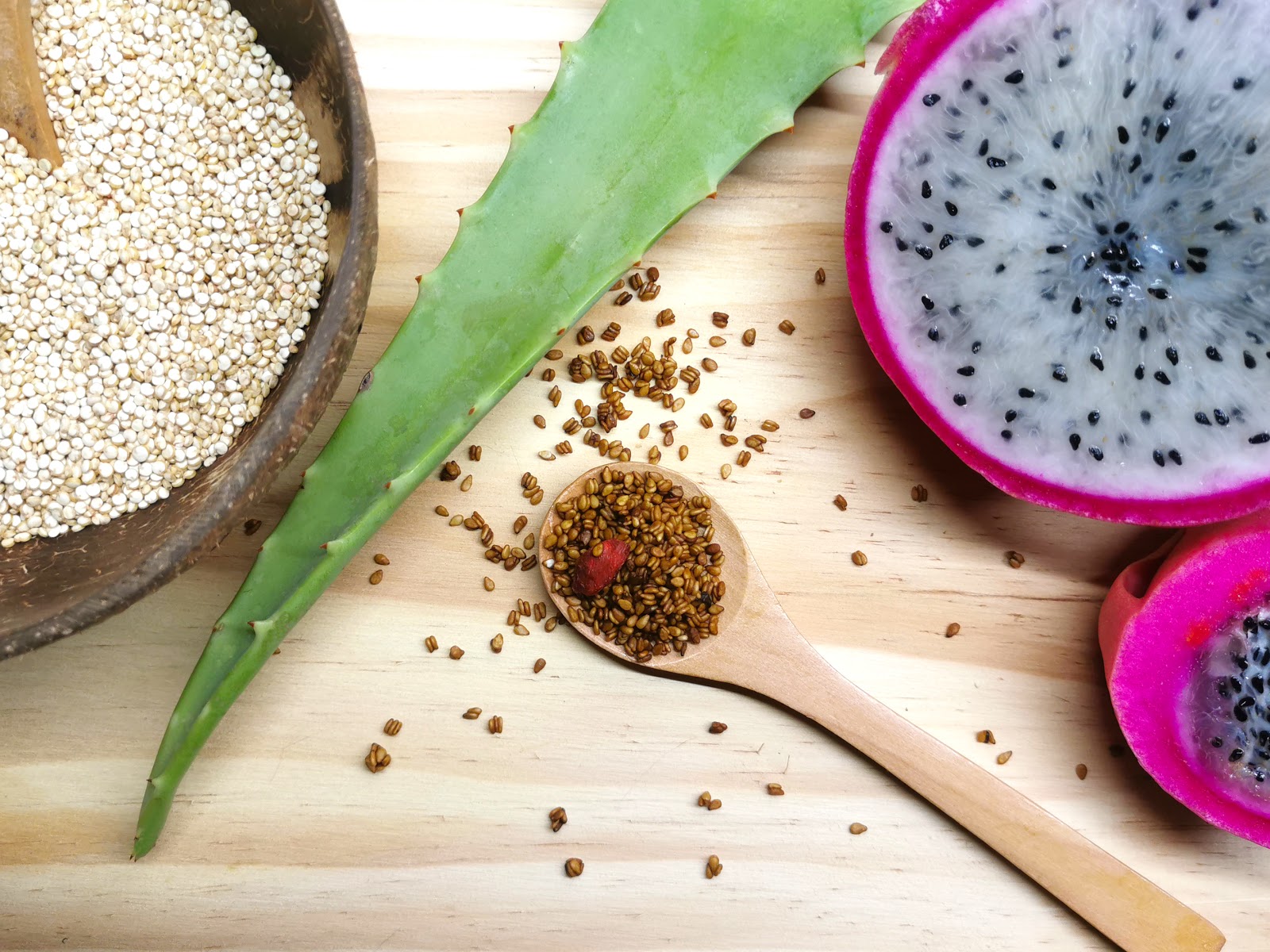Local Storage seems to be disabled in your browser.
For the best experience on our site, be sure to turn on Local Storage in your browser.
Superfoods: Goji Berries, Pitaya, Spirulina, Quinoa

Today, there are many foods classified as superfoods. In this article we will look at the properties and functions of 4 of them.
Goji Berries
Himalayan goji berries, also known as lycium barbarum, may be one of the best foods to fight aging. The goji berry has been used in China for thousands of years to improve health and longevity and is one of the most nutrient-dense foods on earth, with its wide range of phytonutrients, antioxidants, vitamins, and much more.
Goji berries have gained popularity in recent times with more and more people being included in their diet in its various forms, either dry or in juice.
Goji raisins contain 19 amino acids, including essential amino acids. It also contains calcium, potassium, iron, zinc, selenium and vitamins such as vitamin B1, B2, B6, C and E.
It also contains carotenoids including β carotene, lutein, lycopene, and xanthophyll. The carotene content is superior to carrot which provides good antioxidant properties. It also contains essential fatty acids such as linoleic acid which promotes fat loss.
Goji berries also aid in weight loss. Drinking Goji juice has been used as a way to help you lose weight for years. It is said to reduce appetite as well as speed up the fat burning process. Since it also increases energy levels, it is easier to exercise and follow a diet regimen.
The fruits are also very effective for the proper functioning of the liver and kidneys, and are generally taken internally to treat high blood pressure, poor eyesight, diabetes, lumbago, vertigo, and menopausal complaints.
Spirulina
Spirulina is a cyanobacteria that is shaped like a spiral (hence its name), and is blue-green because of the presence of chlorophyll that gives it the green color and phycocyanine, pigment that gives it the blue color.
Spirulina is a superfood that offers more digestible proteins than beef and contains a surprising variety of nutrients: vitamins, minerals, essential fatty acids, nucleic acids, chlorophyll, and a wide range of phytochemicals.
Millions of people around the world use spirulina as a dietary supplement following the recommendations of the United Nations (UN) and the World Health Organization.
The Intergovernmental Institute for the Use of Microalgae Spirulina against Malnutrition recommends the use of microalgae such as spirulina against acute malnutrition in situations of humanitarian emergency, chronic malnutrition, and for sustainable development.
This microscopic seaweed is a quality food supplement rich in assimilable iron that contains more beta-carotene, iron, vitamin B12 and gamma linoleic acid than any other food. It also contains vitamin E, calcium, phosphorus and magnesium.
It is low in saturated fat, unlike other foods with high nutritional value, such as dairy and meat, and provides essential fatty acids, which cannot be found in meat, eggs and dairy products. It is also low in calories.
Spirulina is especially effective in cases of anemia, demineralization and exhaustion. It helps to recover the physical form, the energy and the vitality and to detoxify the organism.
Spirulina is a source of vitamin B-12, essential for the health of nerves and tissues, especially for vegetarians or vegans.
Spirulina is also a powerful regenerator of the intestinal flora and is a powerful activator of the cellular mechanisms of detoxification. It nourishes and protects the liver and kidneys. Spirulina is rich in iron and is easier to absorb than other dietary supplements. Iron is essential for building a strong immune system, and is the most common mineral deficiency.
Pitaya
The pitaya, also known by the name of dragon fruit is a fruit native to Central America. It has an oval shape, with thorns on the outside and three varieties can be found: yellow on the outside and white pulp with seeds on the inside, red on the outside and white pulp or red pulp with seeds on the inside. It is very aromatic and its taste is very sweet and pleasant.
The pitaya is a treasure from the nutritional point of view, contains antioxidants, mucilages, ascorbic acid, phenols. It is rich in Vitamin C, also contains vitamins of the B group, minerals such as calcium, phosphorus, iron, and has high water content and has vegetable protein and soluble fiber. The seeds, which are edible, contain beneficial fatty acids. And one of its most outstanding properties is its anti-inflammatory and antioxidant action, which is why the WHO recommends its consumption.
The pitaya has numerous properties and functions, among them all stand out:
- - Delays cellular aging.
- - It strengthens the immune system by stimulating the production of white blood cells, red blood cells and platelets.
- - It has an anti-inflammatory effect.
- - It helps us to regulate the intestinal transit, and its seeds have a laxative effect.
- - It helps us to prevent kidney stones.
- - It regulates the blood sugar level.
- - Stimulates collagen production.
- - Improves iron absorption (essential to prevent or combat iron deficiency anemia).
- - Excellent for the formation of bones and teeth.
- - Being rich in water and low in carbohydrates its consumption is excellent for people who make slimming diets.
Quinoa
Quinoa is a superfood that cannot be missing from your shopping list, not only because of its delicious taste but also because of its multiple health benefits. This seed comes from the Andes and is rich in vitamins and minerals.
Quinoa is nothing more than a seed, but has unique characteristics as it can be consumed as a cereal. As such, quinoa provides most of its calories in the form of complex hydrates, but also provides about 16 grams of protein per 100 grams and offers about 6 grams of fat in the same amount of food.
If we compare quinoa with most cereals, it contains many more proteins and fats, although the latter are mostly unsaturated, highlighting the presence of omega 6 and omega 3 acids. Regarding the caloric intake, quinoa is similar or slightly higher than a cereal, as it contains less hydrate.
Also, we must emphasize its high contribution of fiber, as it can reach 15 grams per 100 grams, being mostly insoluble type fiber as they characteristically have the seeds.
If we refer to micronutrients, in the quinoa highlights the content of potassium, magnesium, calcium, phosphorus, iron and zinc among the minerals, while it also offers B vitamins in appreciable amounts and vitamin E with antioxidant function.

